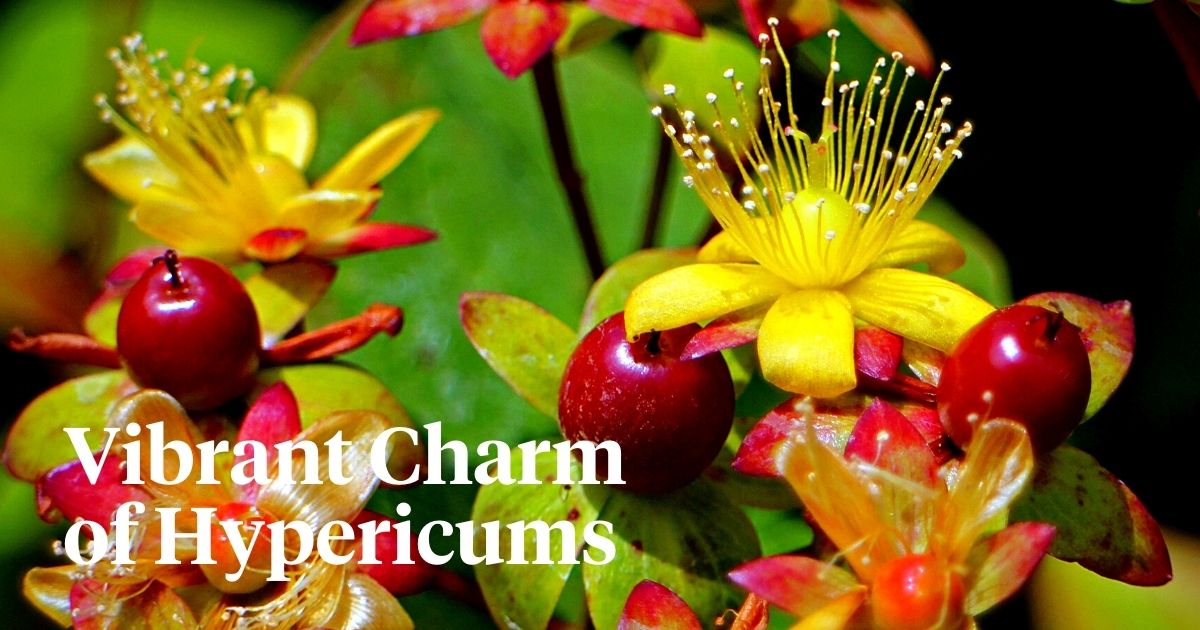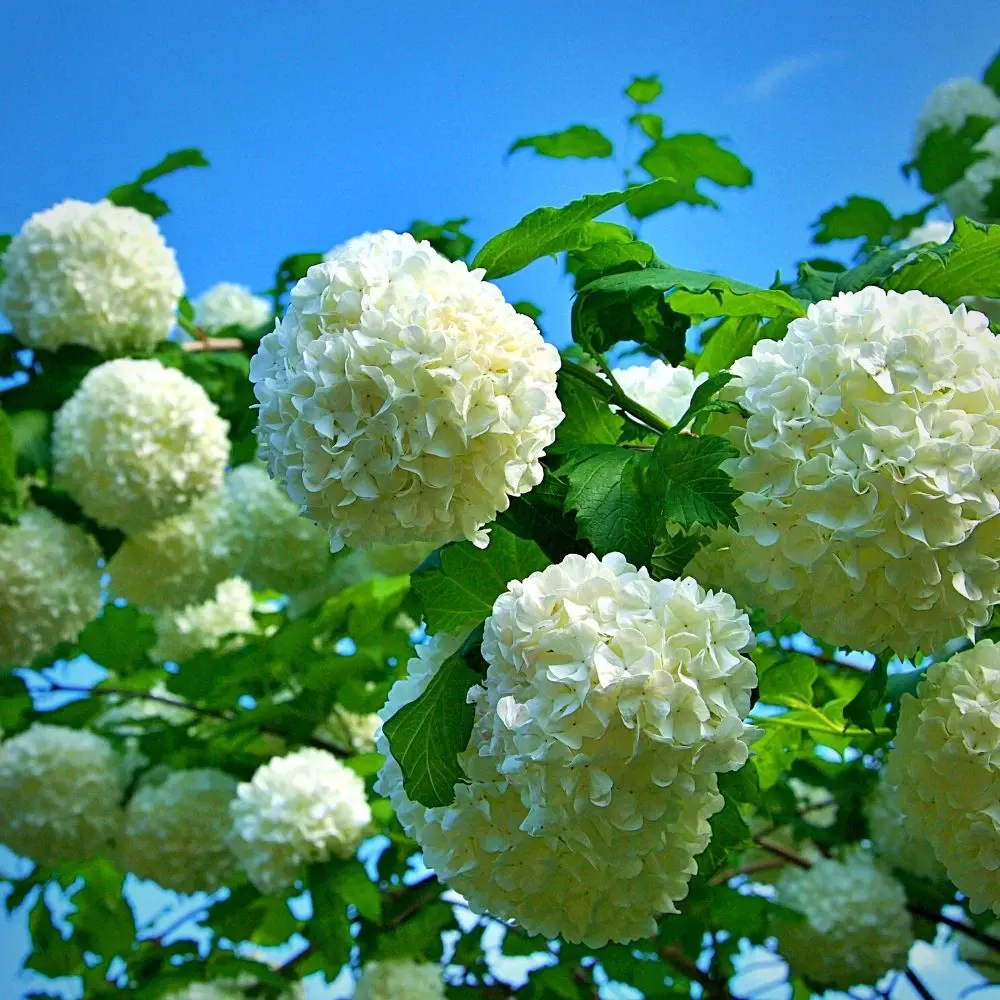With petals that resemble golden sunbursts, tinged with fiery orange and passionate red, the Hypericum stands out as a flower whose celestial radiance lights up every corner it graces. With its sunny disposition, the flower’s blooms, just like tiny suns, symbolizes hope, resilience, and power.
The allure of the Hypericum extends far beyond its visual appeal. For centuries, this venerable genus has been celebrated for its remarkable healing properties and medicinal prowess. Ancient cultures cherished the Hypericum as a symbol of light, harnessing its energy to promote well-being and dispel gloaming from both body and spirit.
What Is the Hypericum Flower A.k.a St John's Wort?
The Hypericum flower, also known as St. John's Wort, is an enchanting plant that not only captivates the senses but offers potential benefits for our well-being. With its stunning array of colors and diverse Hypericum varieties, it adds vibrancy to gardens and landscapes and enhances wellness while still holding a rich historical significance.
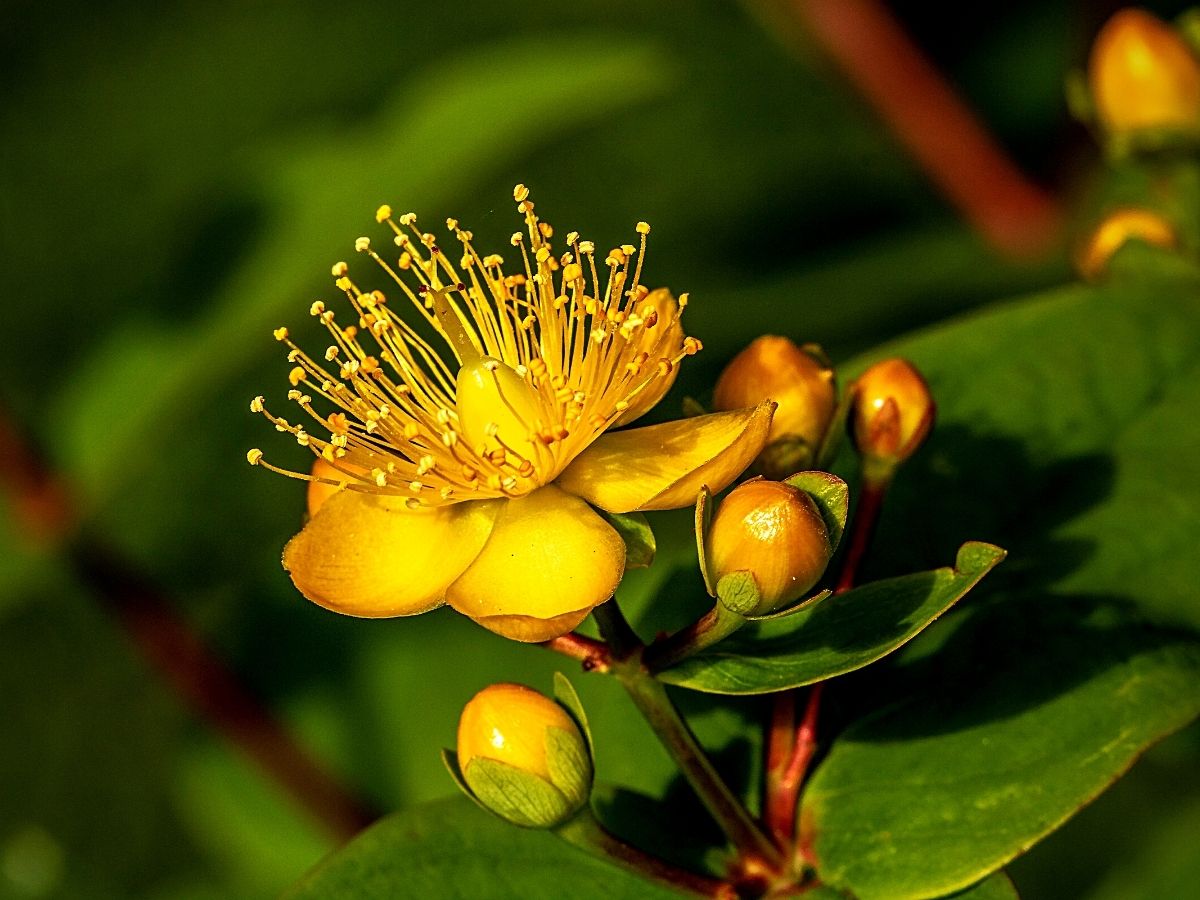
This flower which is scientifically referred to as Hypericum Perforatum is a perennial plant that earned the moniker ‘St. John's Wort’ due to its historical association with St. John's Day observed on June 24. It is renowned for its stunning blossoms and therapeutic properties.
It is a botanical gem that stands tall, reaching heights of up to three feet, adorned with delicate flowers that come in an array of captivating hues, including green, red, pink, orange, and white.
The Most Popular St John's Wort Plant Varieties
With its wide range of varieties, each boasting its own unique attributes and charms, Hypericum berries offer an array of choices for garden enthusiasts and herbal enthusiasts alike. The most popular St John's Wort varieties, such as Hypericum Calycinum, Androsaemum, Frondosum, Prolificum, Hidcote (Brigadoon), and Blue Velvet, among others, showcase the diverse range of colors, textures, and forms that this remarkable plant has to offer. As you look to have this beauty in your garden, there are some popular varieties that you can invest in.
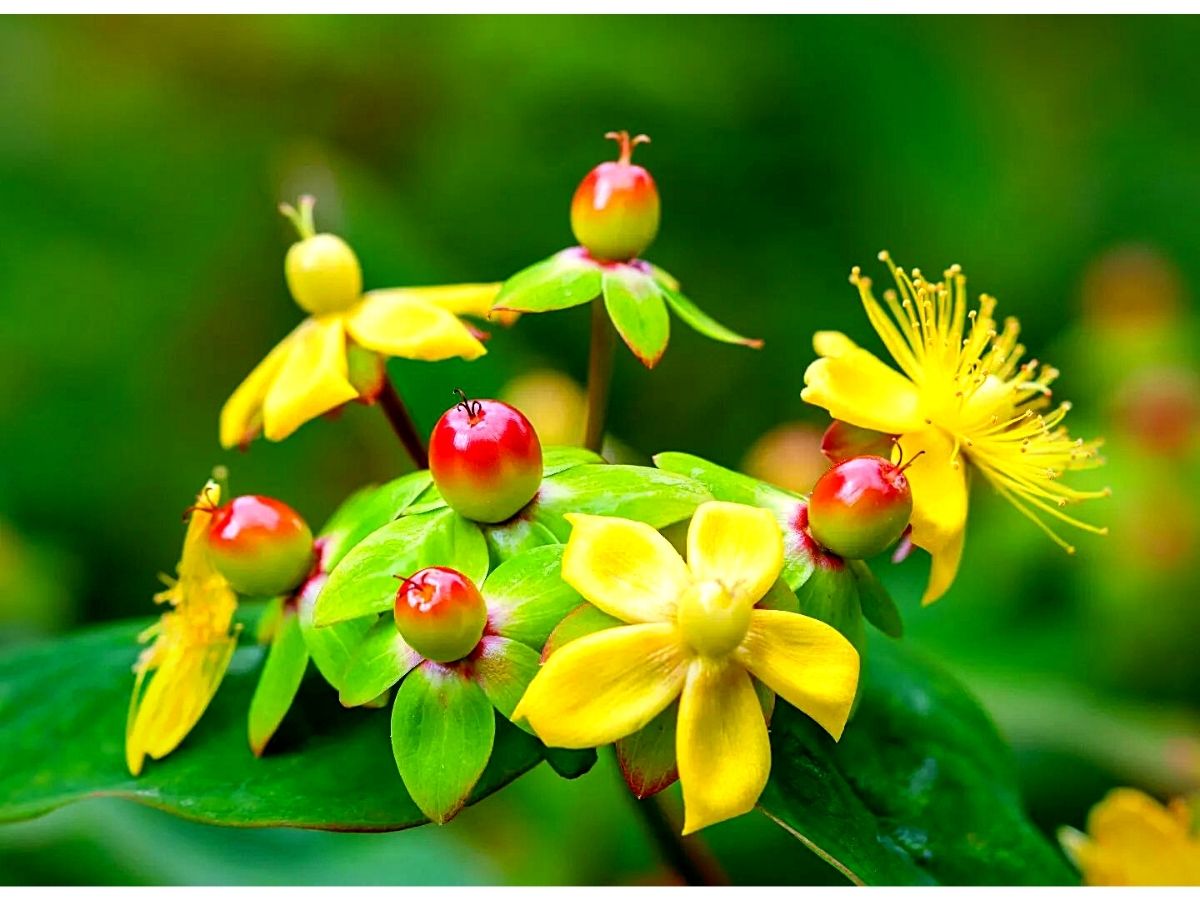
Hypericum Calycinum (Rose of Sharon)
With its vibrant yellow flowers and glossy leaves, Hypericum Calycinum, also known as Rose of Sharon, is a favorite among gardening enthusiasts. This low-growing evergreen shrub typically reaches a height of one to three feet (30 to 90 cm) with a spread of two to four feet (60 to 120 cm).
Its dense growth habit and sprawling branches create a thick carpet of attractive, leathery, dark green leaves that provide year-round interest.
One of the highlights of Hypericum Calycinum is its vibrant flowers. From late spring to early summer, it produces an abundance of showy, cup-shaped blooms. Each flower flaunts five petals in a striking golden-yellow hue, adding a touch of sunshine to any landscape.
The flowers are not only visually appealing but also attract pollinators like bees and butterflies, contributing to the health and diversity of the ecosystem.
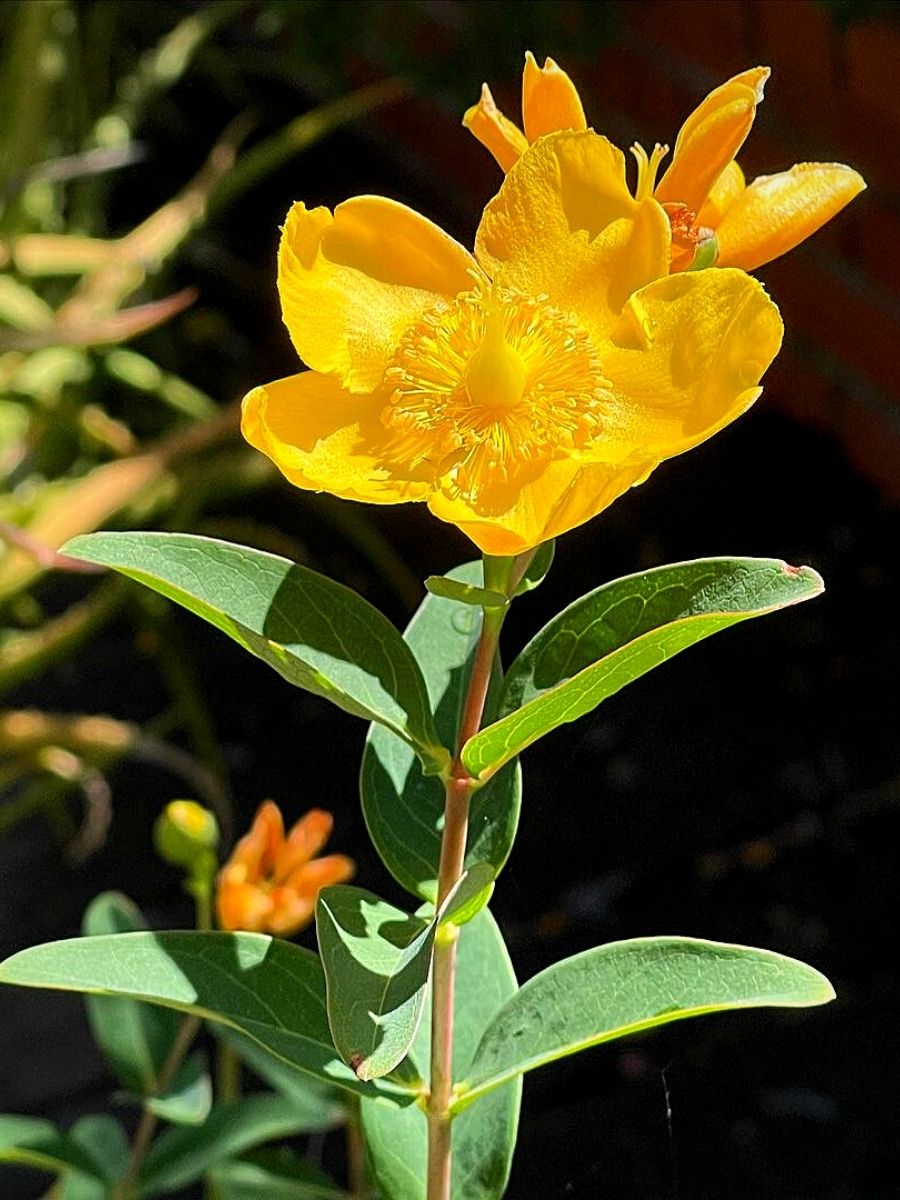
Hypericum Calycinum’s low maintenance requirements and tolerance for various soil conditions make it a versatile choice for both novice and experienced gardeners.
Hypericum Prolificum (St. John's Wort)
Native to North America, Hypericum Prolificum is a species that celebrates the essence of St. John's Wort. It showcases bright yellow flowers and glossy leaves, exuding an air of natural elegance. This hardy plant is known for its drought tolerance, making it an excellent choice for landscaping projects in regions with less rainfall. Additionally, its berries provide nourishment for wildlife, contributing to the ecological balance of the environment.
This deciduous shrub typically reaches a height of three to six feet (one to two meters) and spreads equally wide. Its branches form an attractive, rounded shape, adorned with glossy, dark green leaves that create an elegant backdrop for the plant's other distinguishing features.
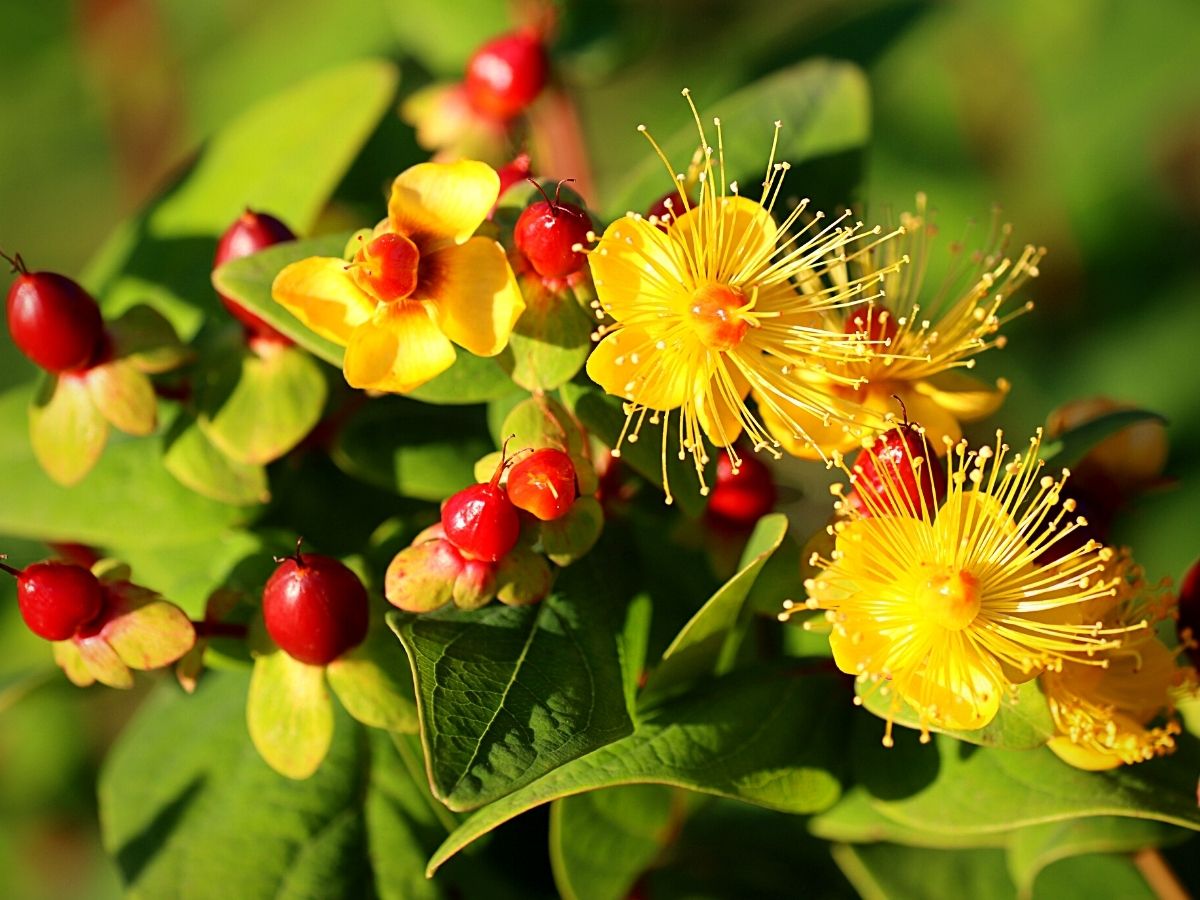
In early to mid-summer, Hypericum Prolificum bursts into a profusion of vibrant yellow flowers, with each bloom consisting of five petals and a central cluster of stamens, attracting pollinators like bees and butterflies. The blossoms provide a delightful contrast against the lush foliage, brightening up the landscape and adding a touch of sunny cheer.
Hypericum Androsaemum (Tutsan)
The Hypericum Androsaemum, or Tutsan, is a visually striking variety that captivates with its alluring green foliage and ornamental berries. The Hypericum Androsaemum berries transition from green to shades of red, creating a beautiful display of colors.
This Hypericum variety is not only adored for its aesthetics but also for its use in dried flower arrangements, as it adds a fascinating touch to floral creations.
The deciduous shrub typically grows to a height of three to five feet (90 to 150 cm) and its arching branches are adorned with opposite, oval-shaped leaves that have a leathery texture. The leaves’ luscious shade of dark green, provides an elegant backdrop for the plant's other captivating features.

One of the defining characteristics of Hypericum Androsaemum is its ornamental berries. Starting as green, the berries transition through various shades of red, eventually turning deep purple or black when fully ripe. These berries are spherical and covered in small dots, resembling tiny jewels against the lush foliage.
Hypericum Hidcote (Brigadoon)
Hypericum Hidcote also referred to as Brigadoon, is an enchanting variety that adds a touch of drama to any landscape. Its deep green foliage serves as an exquisite backdrop for the delicate, saucer-shaped flowers. Brigadoon's beauty lies in its intricate detailing, with petals showcasing hues of pink, red, and orange, making it a standout feature in gardens or floral arrangements.
The versatile shrub similarly adapts well to various garden settings. It thrives in full sun to partial shade, making it suitable for both open spaces and partially shaded areas. Whether you have a traditional garden, a cottage-style landscape, or a contemporary design, Hypericum Hidcote can seamlessly blend in and enhance the overall aesthetics.
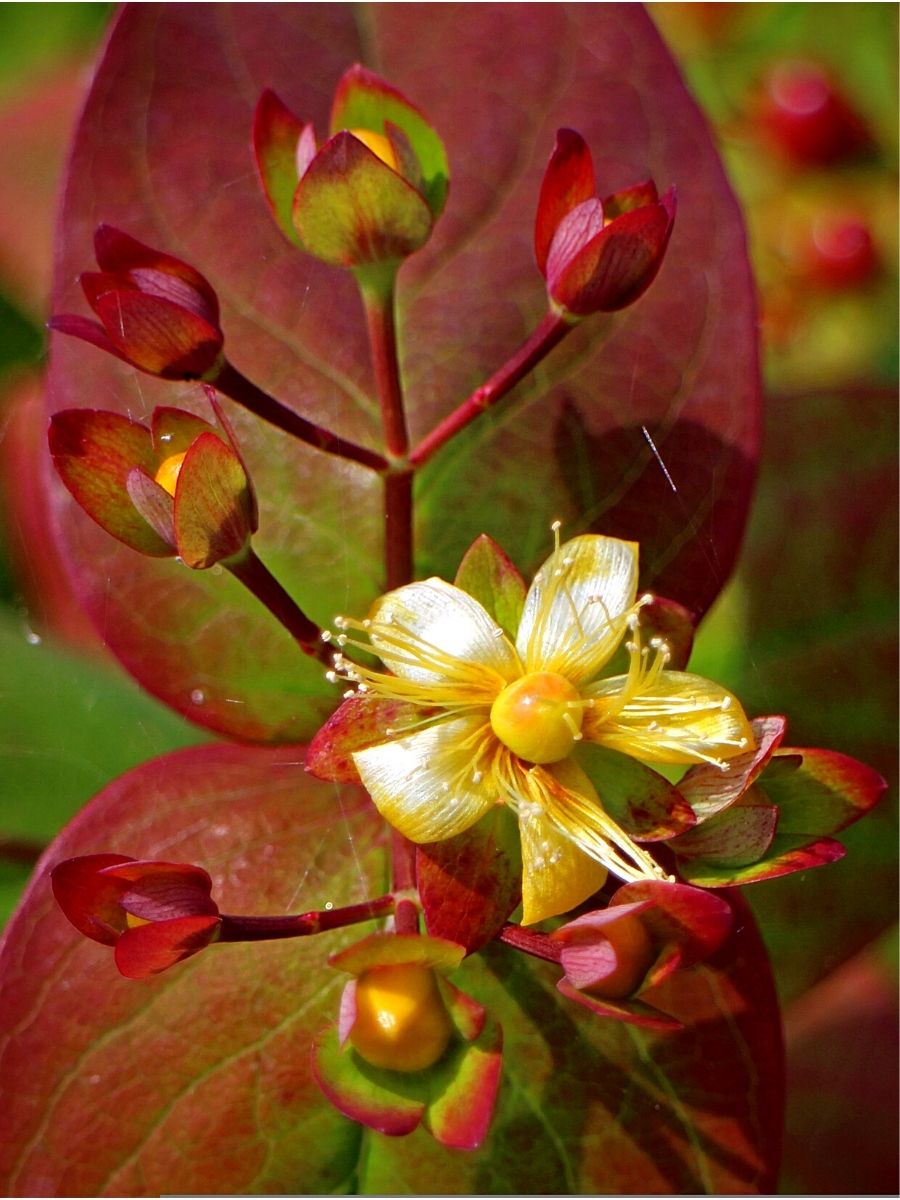
This St John's Wort variety is relatively adaptable to different soil types, including clay, loam, and sandy soil. It prefers well-drained soil but can tolerate moderately moist conditions. With its moderate drought tolerance, Hypericum Hidcote is well-suited to regions with varying rainfall patterns.
Hypericum Hypericoides (St. Andrew's Cross)
Hypericum Hypericoides, commonly known as St. Andrew's Cross, is a charming and delicate member of the Hypericum family. This perennial shrub captivates with its unique foliage and eye-catching flowers, making it a beloved choice for garden enthusiasts and nature lovers.
It is a deciduous shrub that typically grows to a height of one to three feet (30 to 90 cm) and spreads equally wide. Its slender branches are adorned with narrow, lance-shaped leaves that are a luscious shade of green. The leaves form distinctive crosses or 'X' shapes, hence the common name 'St. Andrew's Cross.'

One of the defining characteristics of Hypericum Hypericoides is its striking flowers. From mid-summer to early fall, it produces clusters of small, bright yellow blossoms. Each flower consists of four petals arranged in a cross shape, further accentuating the unique pattern of the foliage. These vibrant flowers create a cheerful and inviting atmosphere in any garden or landscape.
Hypericum Frondosum (Sunburst)
Radiating with golden-yellow blooms, Hypericum Frondosum, commonly known as Hypericum Sunburst, is a delightful addition to any garden or landscape. This variety thrives in various soil conditions and is renowned for its resilience and adaptability.
This deciduous shrub enchants with its vibrant yellow flowers, glossy foliage, and remarkable adaptability, and gives an impression of sunshine, brightening up borders, hedges, and flowerbeds, and creating a picturesque display that will uplift the spirits of all who behold it.
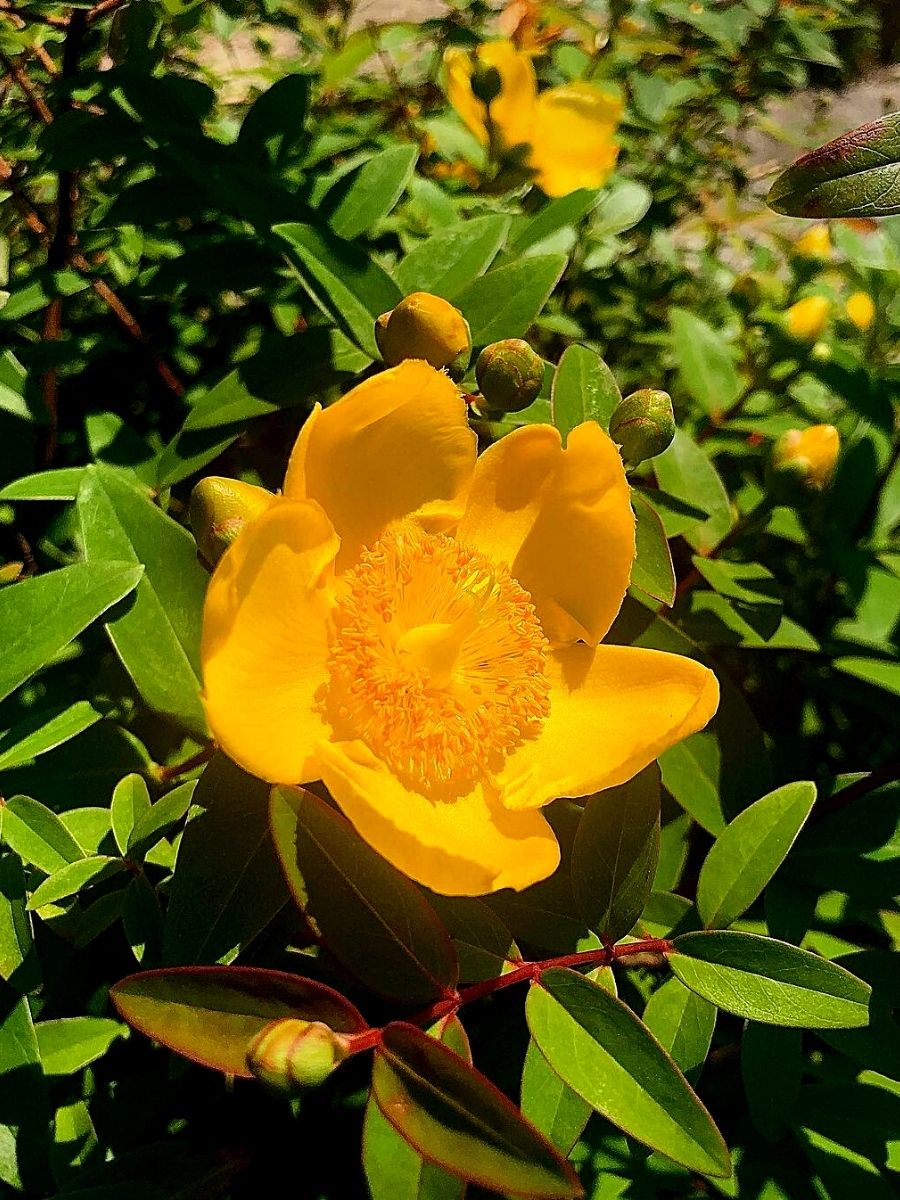
Sunburst is a medium-sized shrub that typically grows to a height and width of three to four feet (90 to 120 cm), with its compact and rounded form adorned with ovate, dark green leaves that have a glossy texture. The foliage provides an attractive backdrop throughout the growing season.
One of the highlights of Hypericum Frondosum is its profusion of golden-yellow flowers. From early to mid-summer, it produces clusters of five-petaled blooms that exude a radiant glow. These striking flowers brighten up the landscape, creating a burst of sunshine in any garden or landscape design.
Hypericum Kalmianum (Kalm St. John's Wort)
Hypericum Kalmianum, commonly known as Kalm St. John's Wort, is a charming and resilient member of the Hypericum family. This versatile shrub captivates with its vibrant yellow flowers, glossy foliage, and ability to thrive in various growing conditions.
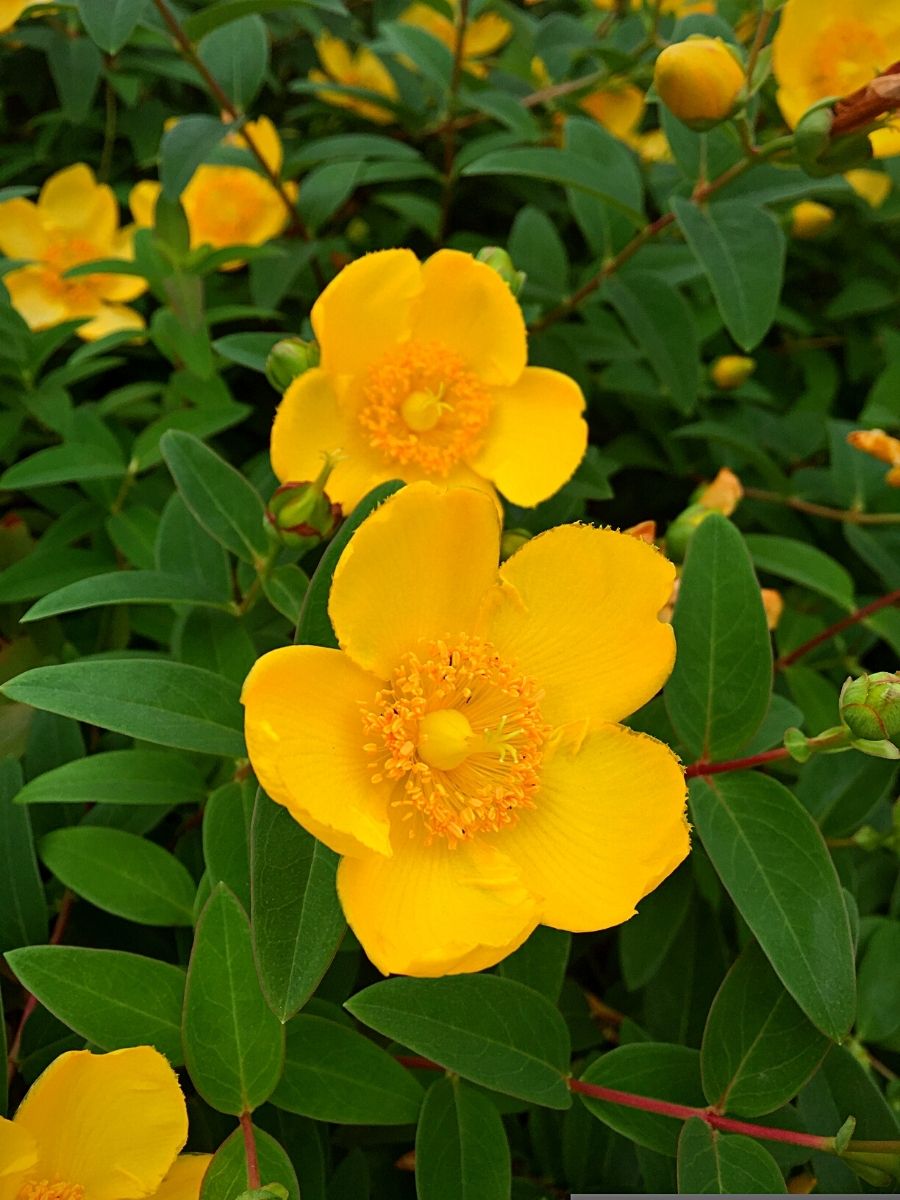
The deciduous shrub typically reaches a height and width of two to three feet (60 to 90 cm). Its compact and rounded form is adorned with ovate to lance-shaped leaves that have a glossy texture. The foliage is a rich green color, providing an attractive backdrop throughout the growing season.
A key highlight of Hypericum Kalmianum is its profusion of vibrant yellow flowers. From late spring to early summer, it produces clusters of showy blooms that brighten up the landscape. Each flower consists of five petals and a prominent cluster of golden stamens, adding a touch of radiance to any garden or landscape design.
Now that you already know the most popular Hypericum varieties, let's dive deeper into this plant's benefits.
What Are the Hypericum Perforatum Uses and Benefits?
From promoting emotional well-being to supporting physical health, Hypericum Perforatum has captured the attention of herbal enthusiasts and health seekers alike. But it's not just its beauty that captivates; it's the healing properties and the potential it holds that have made it a subject of intrigue and study. Some of the Hypericum Perforatum benefits are:
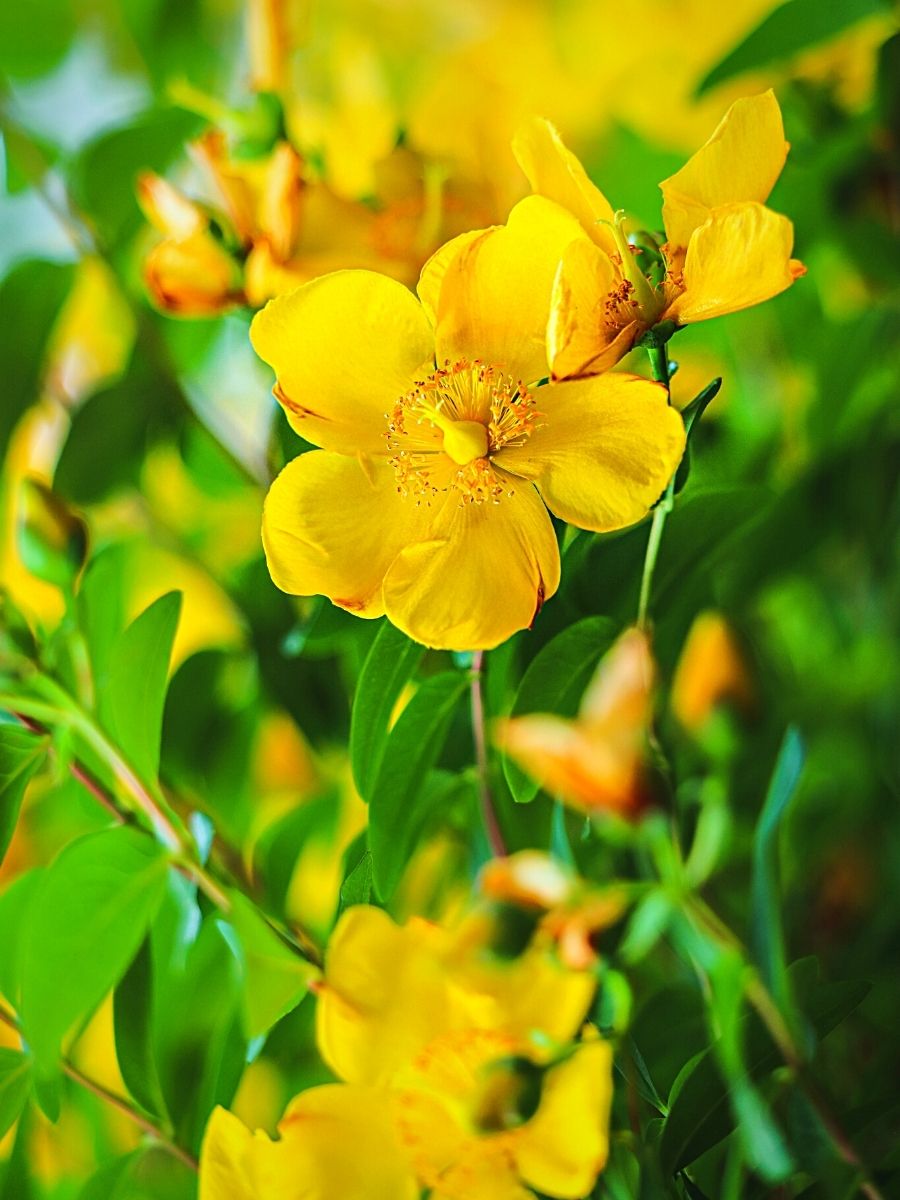
- Supporting Emotional Well-being
One of the well-known uses of Hypericum Perforatum is its potential to support emotional well-being. Traditionally used for centuries, St. John's Wort has been linked to relieving symptoms of mild to moderate depression and anxiety. Its active compounds, including hypericin and hyperforin, are believed to influence the levels of certain neurotransmitters in the brain, such as serotonin, dopamine, and norepinephrine, which play a crucial role in mood regulation.
- Boosting Mental Clarity and Focus
In addition to its potential in promoting emotional well-being, Hypericum Perforatum has been associated with enhancing mental clarity and focus. Many individuals report an improvement in their cognitive function, including increased alertness, concentration, and overall mental performance when using St. John's Wort as a natural supplement.
- Supporting Healthy Sleep Patterns
Hypericum Perforatum has also been linked to promoting healthy sleep patterns. For those struggling with occasional sleeplessness or insomnia, this herb may offer a natural solution. Its calming and soothing properties have been found to help induce a state of relaxation, allowing for a more restful and rejuvenating sleep.
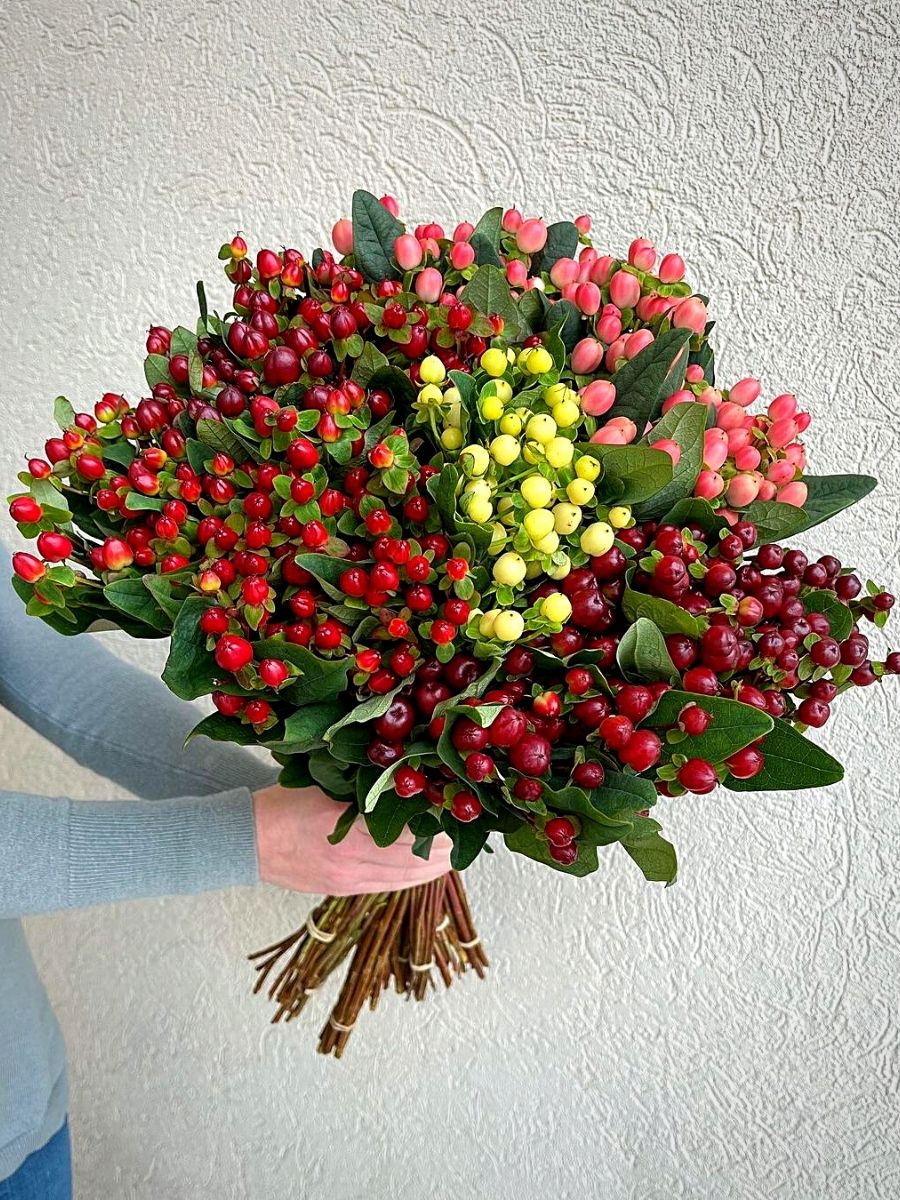
- Supporting Healthy Skin
Beyond emotional and mental well-being, Hypericum Perforatum has a range of external applications, particularly in skincare. The herb possesses anti-inflammatory and antimicrobial properties, making it valuable in the treatment of various skin conditions, such as wounds, burns, minor cuts, and insect bites. It can help soothe the skin, reduce redness and irritation, and promote the healing process.
While the uses mentioned above are among the most widely recognized, Hypericum Perforatum has also been associated with other potential benefits. These include supporting a healthy immune system, providing antioxidant protection, and assisting in relieving nerve pain. Additionally, some individuals have reported positive effects on menopausal symptoms, such as hot flashes and mood swings, when using St. John's Wort.
While Hypericum Perforatum offers numerous potential benefits, it's essential to exercise caution and consult with a healthcare professional before incorporating it into your routine, especially if you are taking medications or have pre-existing health conditions.

How to Care for the St John's Wort Plant
If you're fortunate to have this remarkable herb in your garden, it's important to provide it with the care that it deserves. By following a few essential guidelines, you can ensure that your St. John's Wort plant thrives and continues to provide its therapeutic benefits for years to come.
Select the right location as the plant thrives in full sun to partial shade. Choose a well-drained area in your garden that receives at least six hours of sunlight per day and ensure that there is adequate air circulation around the plant to prevent diseases.
Prepare the soil before planting your St. John's Wort as it prefers well-drained soil with a slightly alkaline to neutral pH. Incorporate organic matter, such as compost or well-rotted manure, into the soil to improve its fertility and drainage.
When planting, dig a hole that is slightly larger than the root ball of your Hypericum plant then place the plant in the hole, ensuring that the crown is level with the soil surface. Backfill the hole with soil, gently firming it around the roots. Water thoroughly after planting.
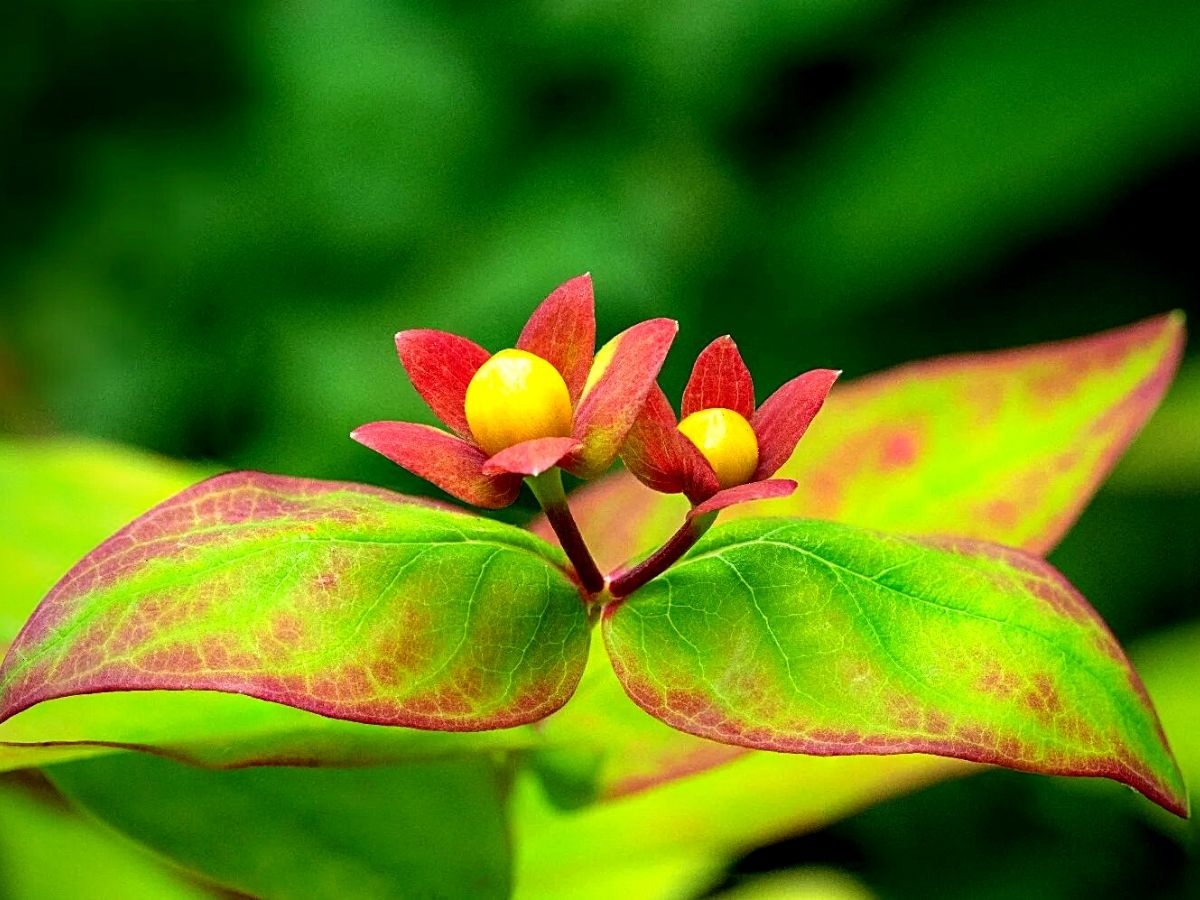
While St. John's Wort is relatively drought-tolerant, regular watering is crucial, especially during the establishment phase. Water it deeply and evenly, allowing the soil to dry slightly between waterings. Avoid overwatering, as it can lead to root rot. You may apply a layer of organic mulch around the base of the plant, such as wood chips or straw. Mulching helps retain moisture, suppresses weed growth, and maintains a more consistent soil temperature.
Pruning is essential for maintaining the health and shape of your St. John's Wort plant. Prune in early spring to remove dead or damaged branches. You can also lightly prune after flowering to encourage bushier growth and promote better air circulation.
The plant generally doesn't require heavy fertilization. However, you can apply a balanced, slow-release fertilizer in early spring to provide essential nutrients. Follow the package instructions for proper application rates.
When it comes to pests and diseases, St. John's Wort is generally resistant. However, keep an eye out for aphids, spider mites, and leaf spot diseases, and if necessary, use organic insecticidal soaps or horticultural oils to control pests, and remove and destroy any affected leaves.

Harvest the flowers and leaves of your St. John's Wort plant when they are in full bloom. Gather them on a sunny day after the morning dew has evaporated. Dry the harvested parts in a well-ventilated area away from direct sunlight to preserve their medicinal properties.
Now that you know about the Hypericum flower, how about you incorporate it in your next gardening or floral design and experience its charm?
Header image by Antranias on Pixabay.

